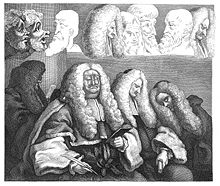The Bench (Hogarth)
[2]He had made an early attempt to address what he perceived as a mistake on the part of his critics with the subscription ticket for his 1743 series Marriage à-la-mode, on which he contrasted a number of his reproductions of classical caricatures – from Annibale Carracci, Pier Leone Ghezzi and Leonardo da Vinci – with his version of some Raphael characters (from the Cartoons) and a hundred of his own character profiles.Hogarth intended to formally address the point with The Bench by creating a print for sale that showed characters, caricatures and outré.[8] Townshend was just the sort of talented amateur Hogarth despised: he used his talents as a caricaturist to attack his political opponents and gain an advantage for himself; by trying to differentiate character and caricature Hogarth hoped place himself in a class with the Renaissance painters and disassociate his work from that of the gentleman caricaturists for whom caricature was an enjoyable distraction or tool for their own advancement.[9][10] The surviving painting and original (first state) print shows four judges sitting below the King's Arms, in session in the Court of Common Pleas.Hogarth ridicules the lack of ability or interest among the judiciary, whose "shallow discernment, natural disposition, or wilful inattention, is here perfectly described in their faces".[12] Willes was known as a hanging judge – he had refused mercy for Bosavern Penlez in the cause célèbre of 1749,[note 1] but was equally famed as a rake, and he is the main target for Hogarth's satire here.It has ever been allowed that when a character is strongly marked in the living face, it may be consider as an index of the mind, to express which with any degree of justness in painting requires the utmost efforts of a great master.As to the French word outré, it is different from the foregoing, and signifies nothing more than the exaggerated outline of a figure, all the parts of which may be, in other respects, a perfect and true picture of human nature.It is said that the king was disposed to have pardoned them both; but that Lord Chief Justice Willes, before whom they were tried, declared in council that no regard would be paid to the laws except one of them was made an example of.
William HogarthFitzwilliam MuseumCambridgeoil-on-canvasCharacters and CaricaturasMarriage à-la-modeThe Analysis of BeautyAnnibale CarracciPier Leone GhezziLeonardo da VinciRaphaelCartoonsRonald PaulsonGeorge TownshendCourt of Common PleasJohn Willespince-nezEarl Bathursthanging judgeBosavern Penlezcause célèbreSheridan Le FanuIn a Glass DarklyOrder of the GarterBenjamin HoadlyStrolling Actresses Dressing in a BarnGeorge HayList of works by William HogarthThe Newgate Calendarpublic wealList of worksEmblematical Print on the South Sea SchemeThe Bad Taste of the TownA Just View of the British StageBefore and AfterThe Company of UndertakersThe Distrest PoetThe Enraged MusicianIndustry and IdlenessBeer Street and Gin LaneThe Four Stages of CrueltyColumbus Breaking the EggSatire on False PerspectiveCredulity, Superstition, and FanaticismFive Orders of PeriwigsJohn Wilkes Esq.The Assembly at Wanstead HouseA Harlot's ProgressA Rake's ProgressSouthwark FairScene from Shakespeare's The TempestFour Times of the DayThe Shrimp GirlPortrait of Captain Thomas CoramTaste in High LifeThe Graham ChildrenCaptain Lord George Graham in his CabinDavid Garrick as Richard IIIPainter and his PugThe Gate of CalaisHogarth's ServantsThe March of the Guards to FinchleyHumours of an ElectionSealing the TombHogarth Painting the Comic MuseThe Lady's Last StakeSigismunda mourning over the Heart of GuiscardoMarriage A-la-ModeLine of beautyHogarth's HouseSarah MalcolmHogarth ClubMary Edwards (Patron)